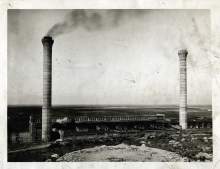This is an archived article that was published on sltrib.com in 2016, and information in the article may be outdated. It is provided only for personal research purposes and may not be reprinted.
Rio Tinto Kennecott will shut down three of its four coal-fired power-generation units in Magna after closing a deal to purchase power from Rocky Mountain Power.
Kyle Bennett, a spokesman for Kennecott, said the deal will eliminate 3,500 tons of particulates — and the pollutants that contribute to the formation of particulates during inversions — from the company's power-generation operation in Magna.
All three units were slated for closure before the Jan. 1, 2018, deadline required by the state's small-particulate implementation plan, Bennett said. Closing this deal with Rocky Mountain Power ensures that Kennecott will have a reliable supply of power and enabled the company to beat that deadline by a year.
"It's a great thing because it fulfills our promise to the community and meets our obligation to shut down a year before the requirement to do so," he said.
All three units have ceased operation and will be decommissioned in the near future, Bennett said.
Kennecott will retain a fourth coal-fired unit at the Magna site, though the state's implementation plan bars the company from using coal to fuel that plant during the winter. Bennett said the degree to which Kennecott chooses to use that plant in the future will depend on market conditions and how much electricity Kennecott needs to meet demand.
The deal with Rocky Mountain Power is set to last nine years, though both companies declined to elaborate on the details of the agreement.
"It's a fair agreement for us," Bennett said. "It provides some benefit for us to have a fair price and to have a knowledge that we have this long-term agreement."
Bennett said the agreement would also benefit Rocky Mountain Power, because Kennecott will help to pay some of the utility's fixed costs over the next nine years.
Paul Murphy, a spokesman for Rocky Mountain Power, said the power provided via the agreement will come from the utility's main six-state grid. Currently, 30 percent of the power on that grid comes from renewable sources.
Much of the power on that grid is also generated by coal-fired units owned by Rocky Mountain Power, but Murphy said the deal would still move coal emissions away from the Wasatch Front, where air quality is of greater concern.
Matt Pacenza, executive director of HEAL Utah, said moving emissions away from the Wasatch Front was a positive for the state's population center.
"That we now have less coal burning on the Wasatch Front is great for improving our air quality, right here on the Wasatch Front," he said. "Any time we can reduce pollution in our northern Utah urban valley, it's a good thing."
But on the other hand, he said, purchasing electricity from Rocky Mountain Power means contributing to coal emissions elsewhere.
"It certainly means plenty of coal-fired electricity and all the air pollution and greenhouse gases that come with it," he said.
The three decommissioned units had a generation capacity of roughly 100 megawatts, Bennett said. But he could not disclose how much power Kennecott has agreed to buy from Rocky Mountain Power.
Murphy said Kennecott and Rocky Mountain Power had been in negotiations regarding the terms of the arrangement for some three years.
"These are big decisions," he said. "What happens with Kennecott impacts the whole state, and what happens with Rocky Mountain Power impacts the whole state … so trying to get everyone at the table is hard to do.
In the end, Murphy said, the deal will be a boon to Rocky Mountain Power ratepayers, because Kennecott will help to pay for the cost of electricity across the entire state.
Twitter: @EmaPen



